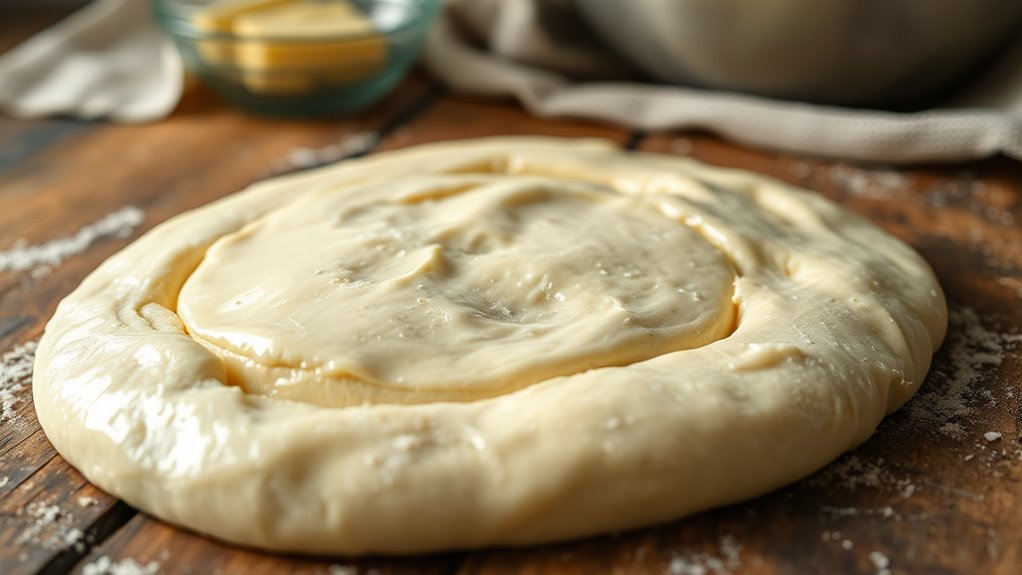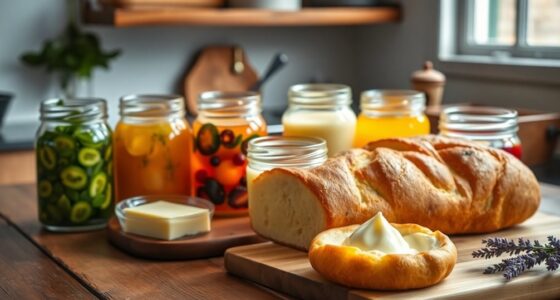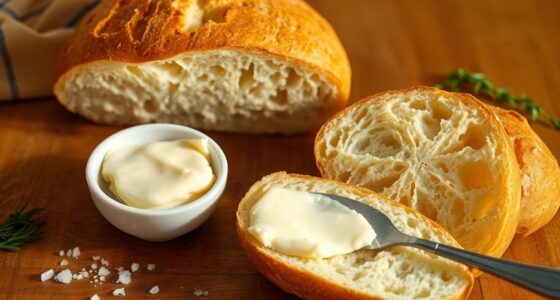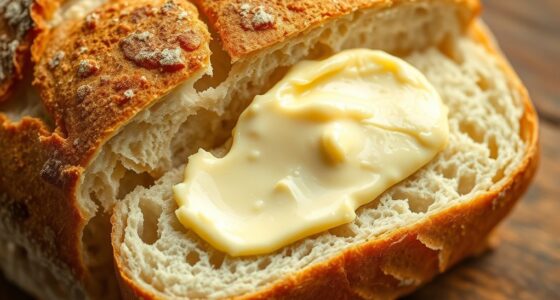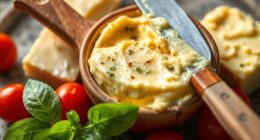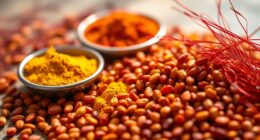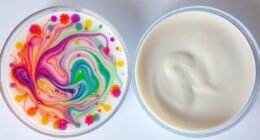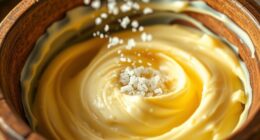When your dough has extra butter, autolyse helps develop gluten without overworking the fat. It allows the flour to hydrate fully while the resting period softens the dough and enhances flavor absorption. Incorporating butter gradually during autolyse prevents weakening the dough’s structure and ensures even distribution. Extending the autolyse or adjusting hydration can counteract butter’s interference with gluten. Keep exploring how to optimize this process for better results and improved texture.
Key Takeaways
- Autolyse enhances gluten development, which can be challenging with extra butter disrupting the gluten network.
- Incorporating butter during autolyse allows flavors to absorb and improves dough elasticity when rested properly.
- Reducing water slightly during autolyse compensates for fat interference, aiding hydration and gluten formation.
- Extending autolyse time helps offset gluten weakening caused by butter, ensuring better dough handling.
- Gradual butter addition during autolyse promotes even distribution, preventing greasy or weak dough structure.
Understanding the Basics of Autolyse
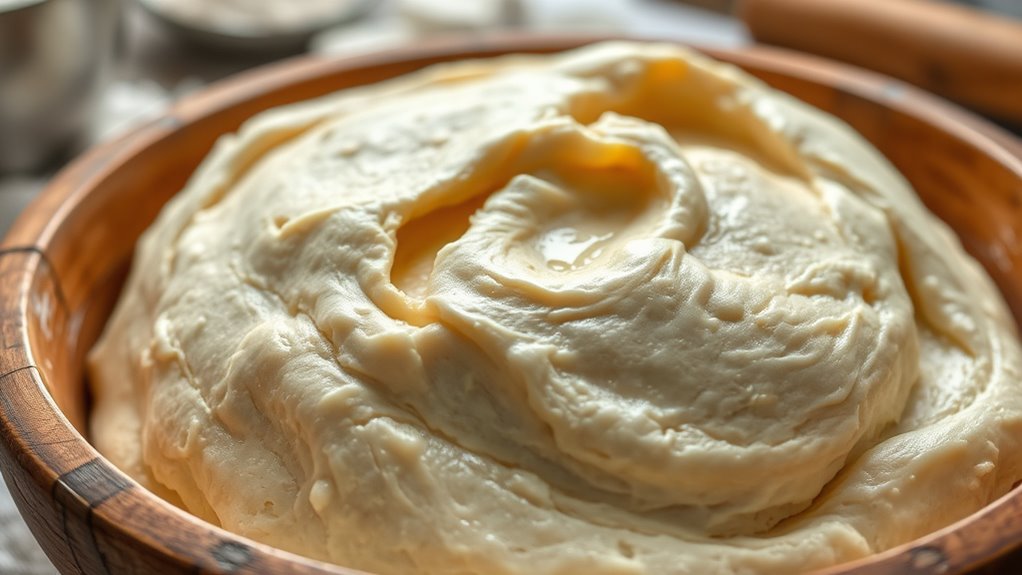
Autolyse is a simple yet effective technique that involves mixing flour and water and letting the dough rest before adding other ingredients. This process helps improve butter distribution by allowing gluten development without kneading, which results in a more uniform dough. The autolyse duration is essential; a shorter period might not fully hydrate the flour, while a longer one can enhance gluten strength. When working with extra butter, autolyse helps the fat integrate smoothly into the dough, promoting even butter distribution. During this rest, the flour absorbs water, making subsequent mixing easier and more efficient. Additionally, using diverse designs like quirky shapes or recycled materials can enhance the visual appeal of your baked goods. By controlling the autolyse duration, you set the foundation for a well-structured dough that handles extra butter effectively. Proper autolyse ensures your final product has excellent texture and flavor.
How Butter Affects Dough Structure
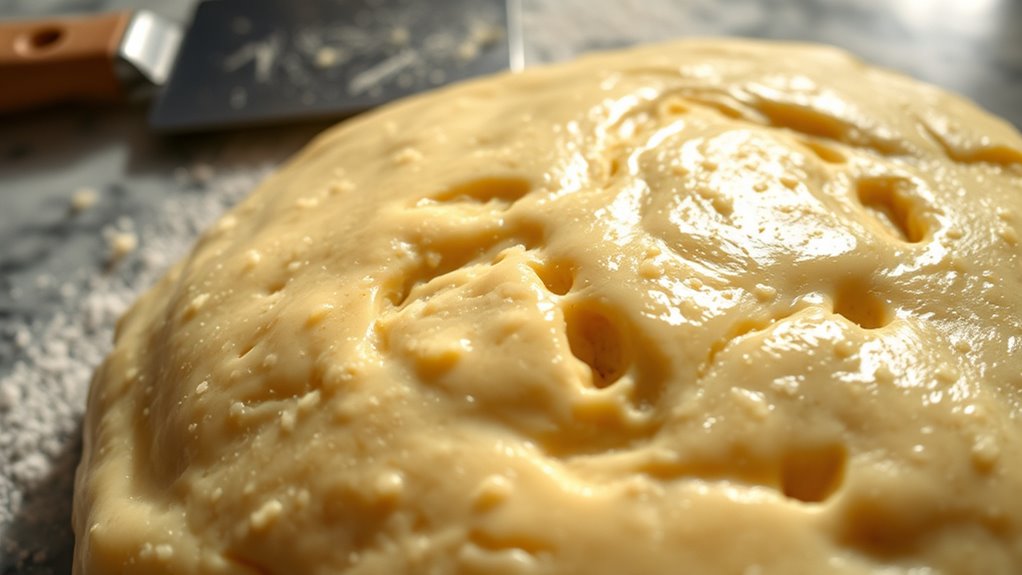
Butter plays a crucial role in shaping dough structure by tenderizing the crumb and creating a richer texture. Its butter flavor adds depth, enhancing the overall taste of your baked goods. When you incorporate extra butter, fat melting occurs during mixing and baking, which influences how the dough develops. This melting process creates pockets of moisture that make the crumb softer and more delicate. The fat also coats the flour particles, limiting gluten formation and resulting in a flakier, more tender crumb. Additionally, understanding dough development can help you better control the final texture of your baked goods. By understanding how butter interacts with the dough, you can better predict its final texture. Keep in mind that the amount of butter impacts not only flavor but also how the dough holds together and rises. Proper integration ensures your baked goods achieve the desired richness and tenderness.
The Science Behind Gluten Development With Extra Fat

Introducing extra fat into dough impacts gluten development by interfering with the formation of strong, elastic gluten networks. When butter is added, it coats flour particles, disrupting gluten matrix formation and limiting gluten strength. This interference affects dough elasticity and structure. To understand this better: 1. Butter distribution around flour particles creates barriers that hinder gluten strands from connecting properly. 2. The fat’s presence weakens the gluten network, making it less cohesive and more tender. 3. Excess butter can cause the dough to be softer and less able to hold its shape, due to interrupted gluten development. Additionally, the presence of fat can influence the shelf life of baked goods by affecting moisture retention and spoilage rates.
Step-by-Step Autolyse Technique for Butter-Heavy Doughs
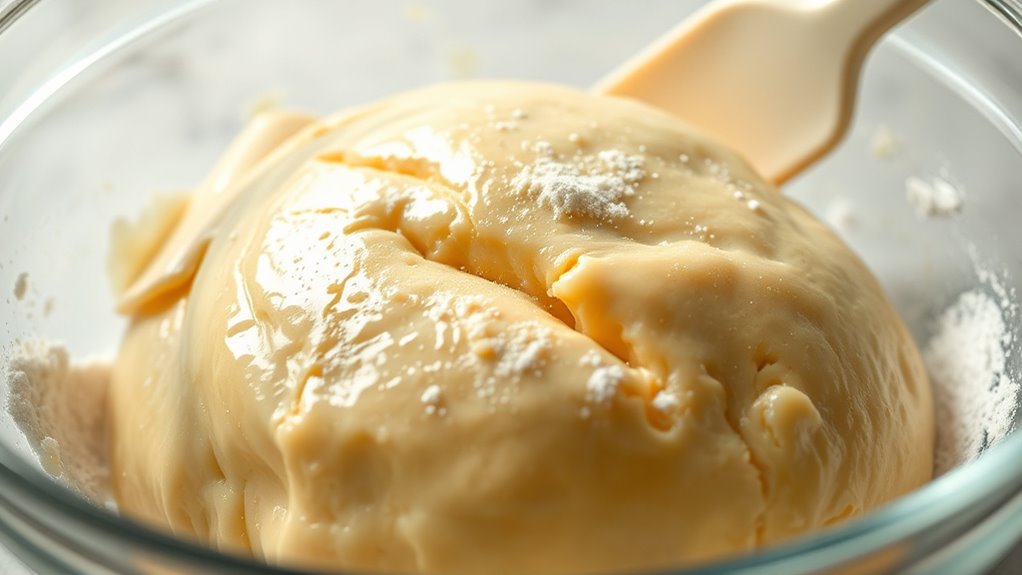
To effectively incorporate butter into your dough, starting with a proper autolyse is essential, especially since the fat can hinder gluten development. During autolyse, mix your flour and water until combined, then let it rest. This process enhances butter flavor absorption and improves dough elasticity. For butter-heavy doughs, consider adding softened butter after initial mixing, but keep the autolyse stage to develop gluten structure without interference. Additionally, maintaining proper gluten development during autolyse helps achieve the desired dough texture.
Benefits of Using Autolyse in Rich Pastry and Bread Making
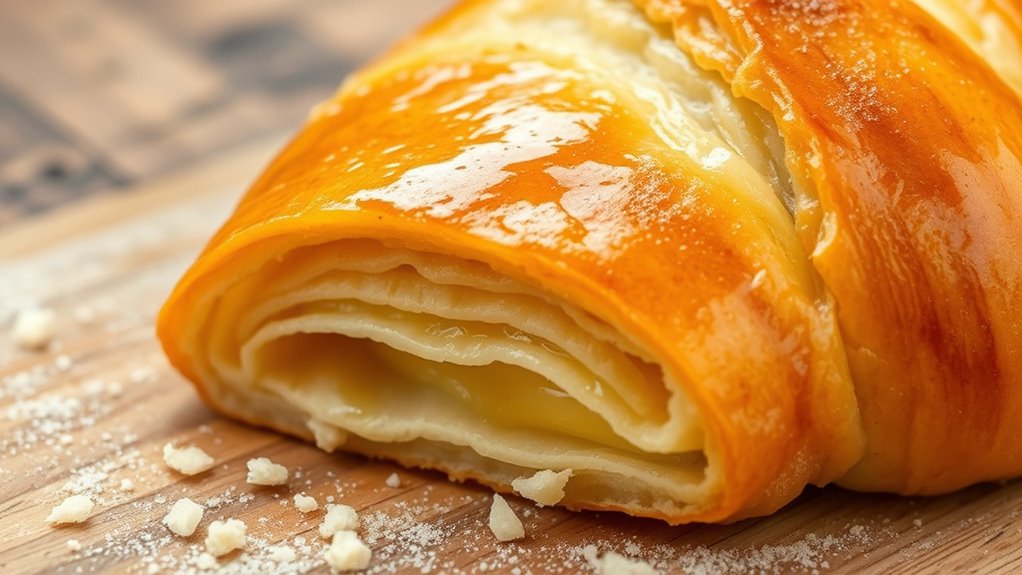
Utilizing autolyse in rich pastry and bread making offers several key benefits that can considerably improve your baked goods. One major advantage is better butter integration, which results in a smoother dough and more even distribution of fat. Proper autolyse timing allows you to develop gluten structure early, making handling easier and enhancing texture. Additionally, autolyse helps activate enzymes that improve dough extensibility and flavor development, especially in butter-rich recipes. To maximize these benefits, focus on a precise autolyse period tailored to your dough’s moisture and butter content. This ensures ideal gluten development and butter incorporation without overmixing. Incorporating autolyse also facilitates enzyme activation, which further enhances dough quality and flavor complexity. Overall, incorporating autolyse strategically elevates your pastry and bread quality, delivering a more tender, flavorful, and well-structured final product.
Common Mistakes to Avoid During Autolyse Process
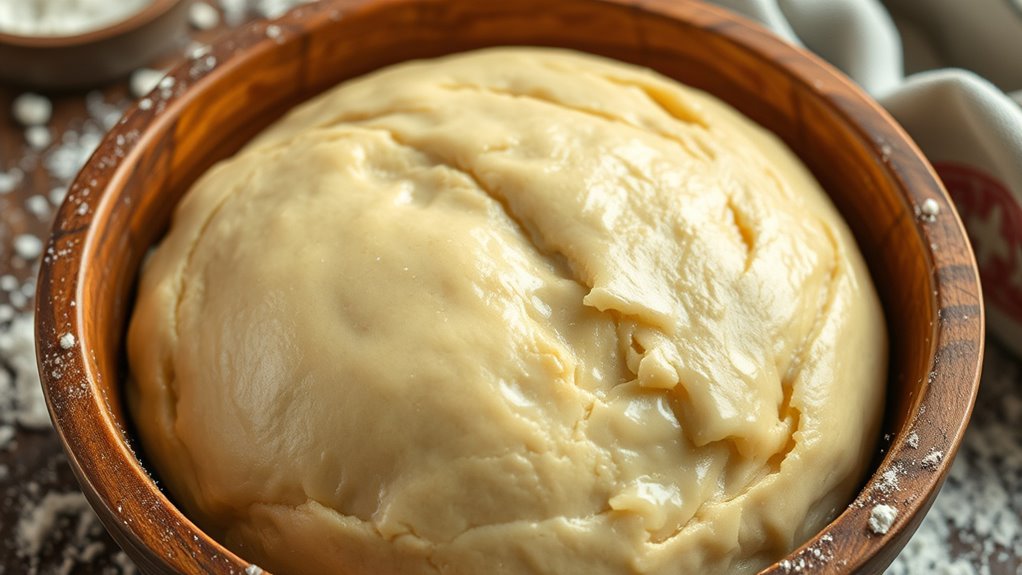
One common mistake is overmixing the dough during autolyse, which can develop too much gluten and affect the final texture. Another is skipping or rushing the rest time, preventing the dough from fully hydrating and relaxing. To get the best results, stick to gentle mixing and give the dough adequate time to rest. Additionally, understanding emotional support can help bakers stay patient and positive throughout the process, especially when facing challenges.
Overmixing Dough Early
Although autolyse is a crucial step for developing gluten and flavor, overmixing the dough early can undermine these benefits. Overmixing pitfalls include breaking down gluten structure prematurely, which hampers dough strength, and disrupting the delicate butter integration techniques. To avoid this, keep these points in mind:
- Mix just until ingredients combine; avoid overworking the dough.
- Resist the urge to knead vigorously during autolyse; gentle mixing preserves gluten integrity.
- Be cautious when adding extra butter, ensuring it’s incorporated gradually without overmixing to prevent greasy or dense dough.
- Understanding the importance of dog names can help in choosing the right personality traits to reflect your baked goods’ character.
Ignoring Rest Time
Ignoring rest time after autolyse can markedly impair your dough’s development. When you ignore proper rest time, you hinder butter absorption, preventing the dough from fully integrating the extra fat. Rest time benefits are vital; they allow gluten to relax and ingredients to hydrate evenly. Without sufficient rest, the dough may be too stiff or unevenly mixed, making it harder to work with later. Rushing through autolyse stops you from maximizing its advantages, especially with extra butter, which needs time to incorporate smoothly. To guarantee ideal gluten development and butter integration, give your dough the necessary pause—this step is key to achieving the desired texture and flavor in your final baked good. Proper rest also helps maintain the authentic farmhouse feel by ensuring a consistent, high-quality dough.
Tips for Optimizing Autolyse When Incorporating Extra Butter
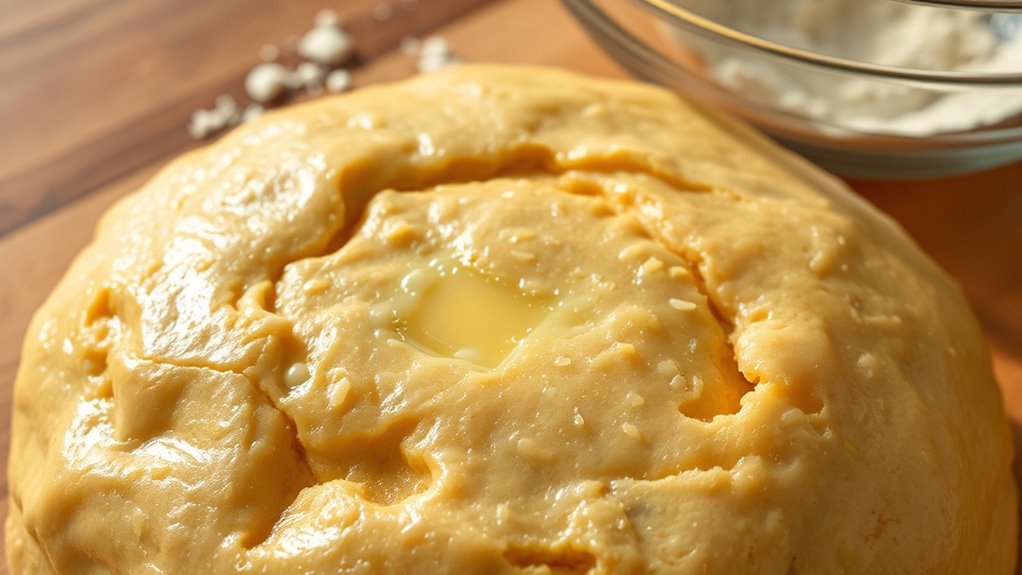
To optimize autolyse with extra butter, you should carefully adjust your dough’s hydration levels to prevent it from becoming too greasy or dry. Extending the resting time slightly can help the flour fully hydrate and improve gluten development. Additionally, incorporate the butter gradually to maintain dough consistency and guarantee even distribution. Using proper meal planning techniques can further ensure consistent results and better manage ingredient ratios.
Adjust Hydration Levels Carefully
When incorporating extra butter into your dough, it is vital to adjust hydration levels carefully, as the fat can interfere with water absorption and gluten development. Too much fat can hinder hydration adjustment, leading to a dense crumb. To optimize autolyse, consider these tips:
- Reduce water slightly to compensate for fat distribution, ensuring the dough remains workable.
- Gradually add water during mixing until the desired consistency is achieved.
- Monitor dough texture closely, as excess fat can prevent proper gluten formation and affect hydration balance.
- Be aware that incorporating fats like butter can impact gluten development, so adjusting hydration accordingly is crucial for achieving the ideal dough structure.
Extend Resting Time Slightly
Extending the resting time of your autolyse can help offset the challenges posed by added butter, which can slow gluten development. When you give the dough extra time, the flour absorbs more moisture, and the butter begins to melt smoothly into the mixture. This process enhances dough elasticity, making it easier to handle and shape later. A slightly longer autolyse allows the gluten network to develop fully despite the presence of fat, resulting in a more resilient dough. Keep in mind that too much resting time can lead to over-fermentation, so monitor your dough closely. By extending autolyse just a bit, you give the ingredients a chance to integrate better, ensuring a better structure and texture in your final baked goods.
Incorporate Butter Gradually
Incorporating extra butter into your autolyse benefits from doing it gradually rather than all at once. Slowly adding butter allows it to melt evenly and integrates smoothly, maintaining excellent dough elasticity. If you add too much at once, the dough may become greasy and lose structure. To maximize this process:
- Add small pieces of butter gradually, giving each time to melt completely before adding more.
- Mix gently to encourage even butter distribution without overworking the dough.
- Observe how the dough’s elasticity responds; a well-incorporated butter will strengthen the dough without making it greasy or limp.
This gradual approach helps ensure your butter melts thoroughly, and your dough retains its ideal texture and strength for better fermentation and baking results.
Frequently Asked Questions
How Does Autolyse Impact Flavor Development in Butter-Rich Doughs?
Autolyse enhances flavor development in butter-rich doughs by allowing better butter integration and flavor extraction. During this resting period, the flour absorbs moisture, activating enzymes that break down starches and proteins, releasing flavorful compounds. This process also helps distribute butter evenly, ensuring a tender crumb. As a result, your dough develops deeper, more complex flavors, and the butter’s richness becomes more pronounced, elevating the overall taste and texture of your baked goods.
Can Autolyse Be Shortened or Extended for Different Butter Types?
Did you know that autolyse times can vary based on butter type? For softer butters that melt easily, a shorter autolyse helps prevent excess dough hydration, ensuring the dough isn’t too sticky. Conversely, firmer butters benefit from a longer autolyse, allowing better absorption and flavor development. Adjust autolyse duration accordingly to optimize butter melting and achieve the perfect dough consistency for your baked goods.
Does Autolyse Improve Dough Elasticity When Using Cold Butter?
You wonder if autolyse improves dough elasticity when using cold butter. Yes, it helps with butter incorporation and gluten relaxation, making the dough more manageable. Cold butter slows gluten development, so an autolyse allows the flour to hydrate fully and relax gluten fibers before adding butter. This process enhances elasticity, ensuring your dough remains tender without becoming overly stiff, resulting in a better texture and easier handling.
How Does Autolyse Influence the Final Crust Texture in Pastries?
Autolyse helps develop the dough’s gluten, which influences the final crust texture. When you use autolyse, it promotes a better crumb structure, resulting in a lighter, more even texture. This process also enhances the buttery aroma in your pastries, making them more fragrant. By allowing the flour and water to fully hydrate, autolyse guarantees your crust turns out crisp yet tender, elevating the overall quality of your baked goods.
Is Autolyse Necessary for All Recipes With High Butter Content?
You might wonder if autolyse is necessary for high-butter recipes. While it’s not always essential, autolyse can improve butter integration and dough resting, leading to a more uniform texture and easier handling. If your dough is particularly rich, a brief autolyse helps hydrate the flour and soften the fat, making mixing smoother. However, for some recipes, skipping it won’t harm the final product, especially if you’re experienced.
Conclusion
Embracing autolyse with extra butter transforms your dough into a tender, resilient masterpiece. Think of it as the secret handshake between flour and fat—a dance that releases perfect texture and flavor. By mastering this step, you don’t just make bread or pastry; you craft an experience. So, next time butter seems overwhelming, remember: patience and technique are your best allies in turning rich ingredients into culinary art.
